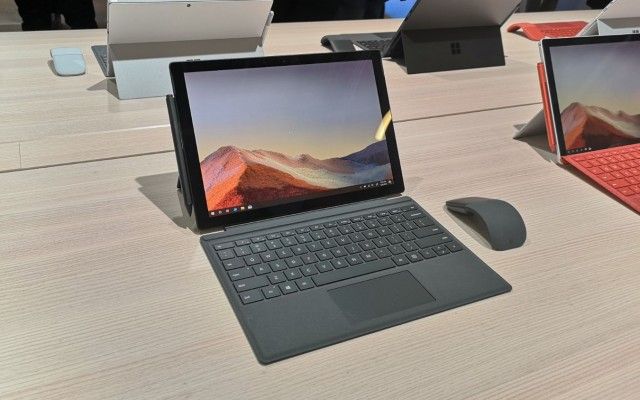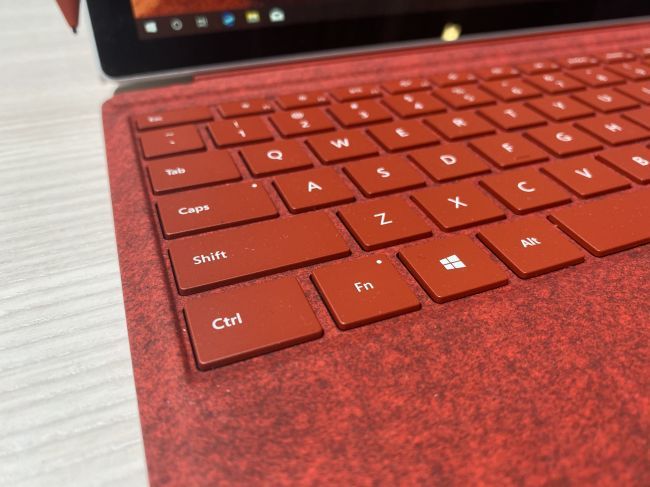Surface Pro 7 vs. Surface Pro 6: What's New?
One of the biggest announcements from Microsoft’s Oct. 2 hardware event was the Surface Pro 7, a new Microsoft hybrid that improves on the Surface Pro 6 with more processor options, plenty of battery life, and the long-awaited addition of a USB-C port.
But in an important twist, Microsoft didn’t discontinue the Surface Pro 6 now that the Surface Pro 7 is available. And, the Surface Pro 6 is now available at a solid discount.
As such, you might be wondering whether the Surface Pro 7 or Surface Pro 6 is the right option for you. Here’s how each version of Microsoft’s flagship 2-in-1 detachable stacks up.
Surface Pro 7 vs. Surface Pro 6 compared
| Row 0 - Cell 0 | Microsoft Surface Pro 7 | Microsoft Surface Pro 6 |
| Starting Price | $749 | $699 |
| Display | 12.3-inch, 2736 x 1824 | 12.3-inch, 2736 x 1824 |
| CPU | 10th Gen Intel Core i3, i5, i7 (Ice Lake) | 9th Gen Intel Core i5, i7 |
| RAM | 4GB, 8GB, 16GB | 8GB, 16GB |
| Graphics | Intel UHD or Iris Plus | Intel UHD 620 |
| Storage | Up to 1TB | Up to 1TB |
| Ports | USB-C, Surface Connect, USB-A, microSD card, Mini DisplayPort, headphone | Surface Connect, USB-A, microSD card, Mini DisplayPort headphone |
| Size | 11.5 x 7.9 x 0.33 inches | 11.5 x 7.9 x 0.33 inches |
| Weight | up to 1.7 pounds | up to 1.73 pounds |
Design and ports
If you happen to glance at the Surface Pro 7 and Surface Pro 6, don’t be surprised if they look nearly identical to you.
They both come with the same 12.3-inch PixelSense screen and feature identical dimensions of 11.5 x 7.9 x 0.33. The Surface Pro 6 is a smidge heavier at 1.71 and 1.75 pounds (depending on the model) compared to the 1.7 and 1.73 pound Surface Pro 7 options.
Sign up to receive The Snapshot, a free special dispatch from Laptop Mag, in your inbox.
Both devices are designed to be used in laptop, studio, and tablet mode, attach to keyboard covers, and work with Microsoft’s Surface Pen stylus.
Display
Nothing to see here, folks. The Surface Pro 7 has the same display as the Surface Pro 6. That means you can expect the 12.3-inch PixelSense to ship with a 2736 x 1824-pixel resolution (that’s 267 pixels per inch) and an aspect ratio of 3:2. It’ll also come with ten-point multi-touch support. That’s all identical to the Surface Pro 6’s display.
Specs
Microsoft is promising lots of extra power in the Surface Pro 7, claiming that the new 2-in-1 is 2.3 times faster than previous generations.
The new model comes with three processor options. The first is a dual-core 10th-generation Intel Core i3 processor, and it’s flanked by a quad-core 10th generation Intel Core i5 and quad-core 10th generation Intel Core i7 processor. They’re supported by your choice of the Intel UHD Graphics chip in the Core i3 model or the Intel Iris Plus Graphics chip in the Intel Core i5 or Intel Core i7 options.
The Surface Pro 6 ships with an older 9th-generation Intel Core i5 and Intel Core i7 processor and the Intel UHD Graphics 620 graphics chip for either model.
There is one big difference, however: the Surface Pro 7 sports a USB-C port, in addition to a Surface Connect port, a USB-A port, a microSD slot, a Mini DisplayPort and a headphone jack. The older Surface Pro 6 lacks a USB-C port, which makes it less ideal for connecting to newer gadgets and USB-C monitors, but otherwise has the same connections.
Storage and Memory
The Surface Pro 6 and Surface Pro 7 are similar, but not identical, when it comes to storage and memory.
Microsoft Surface Pro 7 ships with four solid-state drive options. The smallest of the bunch delivers 128GB of storage, but you can boost it to 256GB, 512GB, or even 1TB. On the memory side, you can increase your RAM from a base of 4GB to 8GB or 16GB, depending on how much performance you need.
Microsoft’s Surface Pro 6 only offers 8GB or 16GB of RAM. However, it has the same 128GB, 256GB, 512GB, or 1TB options for storage.
Battery life
If it’s battery life you’re most concerned about, you might want to go with the Surface Pro 6 over the Surface Pro 7. That’s because Microsoft is promising just 10.5 hours of battery life during "typical device usage" in the Surface Pro 7, compared to 13.5 hours of "video playback" in the Surface Pro 6.
Those comparisons aren't exactly apples-to-apples. For context, the Surface Pro 6 lasted for a strong 9 hours and 20 minutes of continuous web surfing on our battery test, and we expect the Pro 7 to at least match that given its more optimized 10th-gen CPU.
Price and value
Since it’s a bit older, the Surface Pro 6 is the cheaper of the two models. It’s available now for a starting price of $699, but that price will rise considerably, depending on the model you choose and configurations you make. Microsoft is also currently offering a Surface Pro 6 Type Cover bundle for just $999, which gets you the Core i5, 128GB SSD, 8GB RAM version and a full keyboard for a solid price.
When the Surface Pro 7 hits store shelves on Oct. 22, it’ll start at $749 and come in your choice of platinum or black — the same colors available in the Surface Pro 6. A Core i5/128GB/8GB model with Type Cover will run you about $1,028, or $1,058 if you opt for the new Signature model.
Outlook
The Surface Pro 7 isn't a massive upgrade over the Pro 6, but it's likely the best option for folks just jumping in to the Surface Pro family. The addition of USB-C is a long overdue change that should help the Pro 7 play nicer with modern peripherals, and the added power bump from its 10th-gen CPUs is a nice bonus.
However, folks who already own a Pro 6 have little reason to upgrade, and you will save at least $50 if you opt to go with last year's model. We're eager to see if the Pro 7 can become our favorite overall detachable, so stay tuned for our full review later in the year.
Don is a journalist working with Laptop Mag. He writes about some of the best Apple products you need to keep your eyes on, including apps for the iPad, MacBook Air accessories, and the greatest MacBook Pros. Outside of Apple, Don's coverage includes Samsung, Microsoft, and Raspberry Pi. Don has also written for Tom's Guide, Digital TechCrunch, The New York Times, and Forbes. He now runs his own content & PR firm, D2 Tech Agency.





